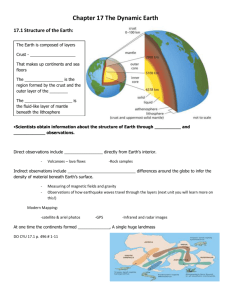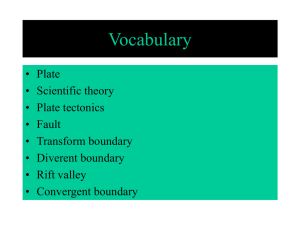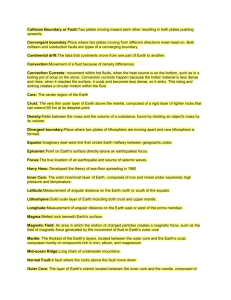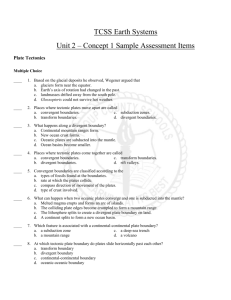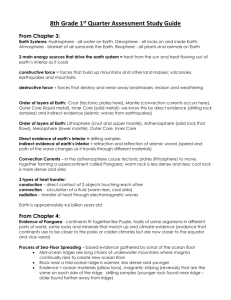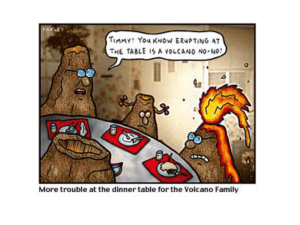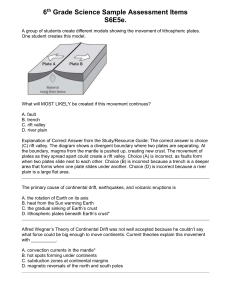Teacher Notes Key
advertisement
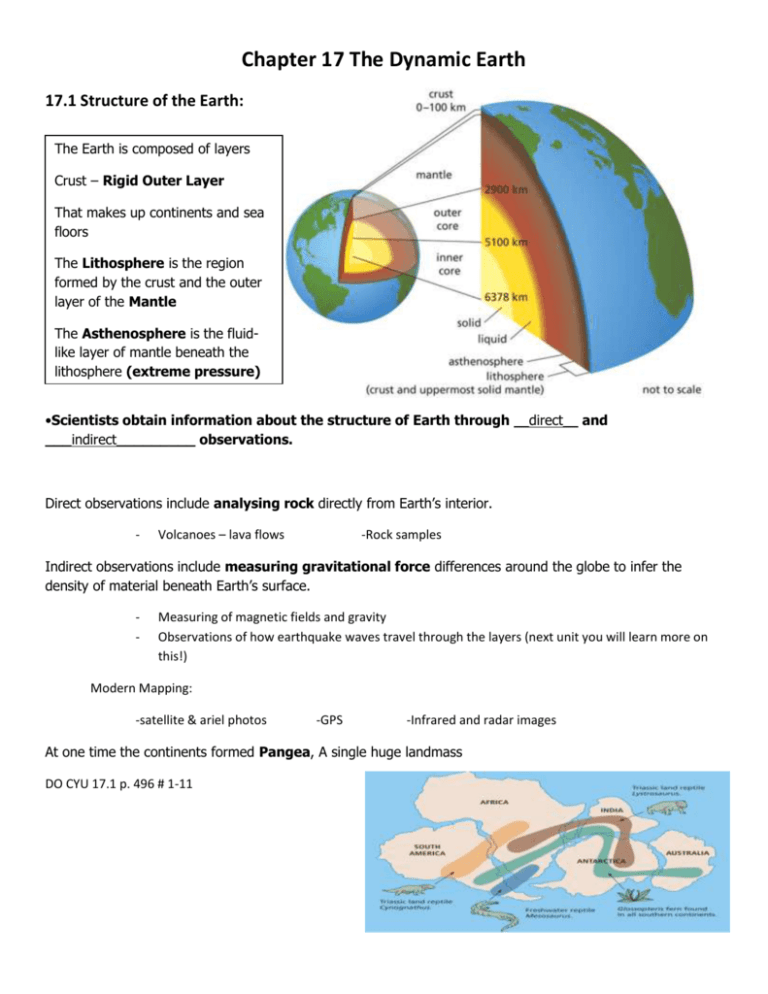
Chapter 17 The Dynamic Earth 17.1 Structure of the Earth: The Earth is composed of layers Crust – Rigid Outer Layer That makes up continents and sea floors The Lithosphere is the region formed by the crust and the outer layer of the Mantle The Asthenosphere is the fluidlike layer of mantle beneath the lithosphere (extreme pressure) •Scientists obtain information about the structure of Earth through __direct__ and ___indirect_________ observations. Direct observations include analysing rock directly from Earth’s interior. - Volcanoes – lava flows -Rock samples Indirect observations include measuring gravitational force differences around the globe to infer the density of material beneath Earth’s surface. - Measuring of magnetic fields and gravity Observations of how earthquake waves travel through the layers (next unit you will learn more on this!) Modern Mapping: -satellite & ariel photos -GPS -Infrared and radar images At one time the continents formed Pangea, A single huge landmass DO CYU 17.1 p. 496 # 1-11 17.2 Evidence of a Dynamic Earth: Continental Drift Theory: The surface of the Earth moves constantly- First proposed by Wegner based on the following evidence: - Puzzle fit of continents Geological coastline matches Fossil matching - Coal deposit matching Equatorial glacial evidence Unfortunately his theory was not accepted until when HOW the continents moved was better understood! DO CYU 17.2 p. 500 #1-7 Sea floor spreading 17.3 New Evidence of a Dynamic Earth: occurs at mid-ocean ridges when magma rises from the mantle and fills in the cracks left by the sea floor moving apart 1. Mid-Ocean Ridges & Maps Mid-oceanic ridges are undersea mountain ranges The sea floor is cycled back into earth at ocean trenches at a divergent boundary subduction zones The discover of mid-ocean ridges where the sea floor was spreading, as well as trenches where continents and oceanic plates met etc. were mapped along with known locations of high volcanic and earthquake history and this showed the boundaries of the “plates” See Fig 1 p. 501 2. Sea-Floor Spreading Heat within the Earth creates convection currents in the mantle that help move the plates. Radioactive dating of core samples confirmed that the sea floor is older the further it is from the ridge When basalt cools the iron particles in the rock align with the earths magnetic field (like tiny compass needles) and since the magnetic poles reverse over earth history, this has created a pattern Radioactive dating When they looked at the mid-ocean ridges closer it was discovered that the rock was youngest at the ridges, and oldest at the trenches where the oceanic plates dip under the continental plates Magnetic Evidence there is also a pattern of magnetic shifts that can be observed moving away from the divergent ocean ridges that show that new plate is forming and moving outward from both sides of this boundary. See Fig 3. P. 503 17.4 Theory of Plate Tectonics: The theory of plate tectonics states that the lithosphere is divided into 12 large segments and about 20 smaller ones. The lithosphere is divided into 12 sections called plates plus 20 smaller ones. These tectonic plates “float” on top of the dense fluid like asthenosphere which creates a push-and-pull on these plates due to large slow moving convection current within it, causing many different plate boundary phenomena The point where two plates move away from each other is called a Divergent Boundary Rift (land), Ridge (ocean) , and Volcanoes/Earthquakes are created at this type of boundary Plates moving towards each other collide at a Convergent Boundary Ocean-ocean islands arc & trench from subduction Ocean-continent trench from subduction, volcano belt mountaints, volcanoes, earthquakes Continent-continent mountains Plates move past each other in opposite directions at Transform Boundary Earthquakes and strike-slip fault lines are created along this type of boundary. , mountaints, Summary of Plate Movement Plate Boundary Convergent Ocean-Ocean Description of Movement Geological Formations Subduction zone Island Arc Volcanoes Convergent Ocean-Continent Subduction zone Trench Volcanoe belt Mountains Earthquakes Convergent ContinentContinent Mountain Range Divergent Oceans = ridges Continent = Rifts Transform Earhquakes Faults Picture Chapter 18 – Plate Tectonics 18.1 Causes and Effects of Plate Movement: Shaping the Earth: Push: out at divergent boundary where sea floor spreading is occuring Pull: down at subductions zones Convection: created when the core heats the liquid like mantle which then cools as it rises … and is density dependant CYU 18.1 p. 521 #1-10 DO Worksheet with new seating partners 18.2: Geological Events: Volcanoes: - mark cracks in the lithosphere where magma & gas reach the surface - Found at: Mid-Ocean Ridges Volcanic Belts - Parallel to convergent ocean-continental boundary (on continent) Volcanic Island Arcs – parallel to convergent oceanic-oceanic boundary Hot Spots – above a spot of very hot mantle. Often resulting in Volcanic island chains eg. Hawaii Is. Earthquakes: - mark locations where transform boundaries form faults Epicenter – location directly above the focus Focus – location where the earthquake originated underground P OR COMPRESSIONAL WAVES – Primary Travels in the same direction as the wave Can travel through solids, liquids and gasses S OR SHEAR WAVES – Secondary (slower) Travels perpendicular to the wave direction Can travel through solids only ***P waves travel faster (about 1.7x) than s waves What do P-waves and S-Waves provide indirect evidence for? 1 Distance to the Epicenter: since the p wave and s wave travel at different speeds, the time interval between when they reach a seismograph can be used to determine the distance from the epicents 2 Indirect information about the layers of the earth: tells us the depth, density and state of the different layers of the earth (faster)
